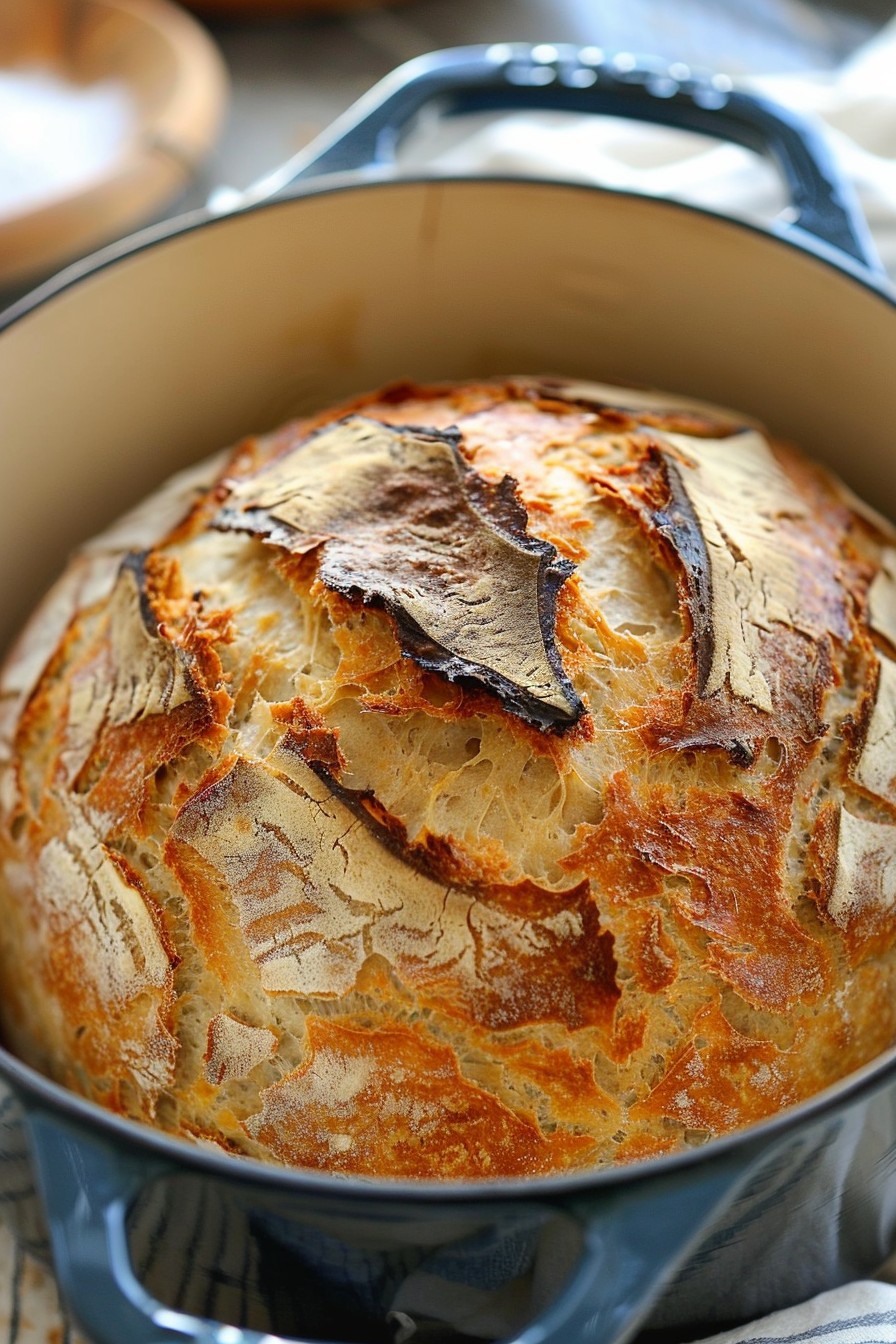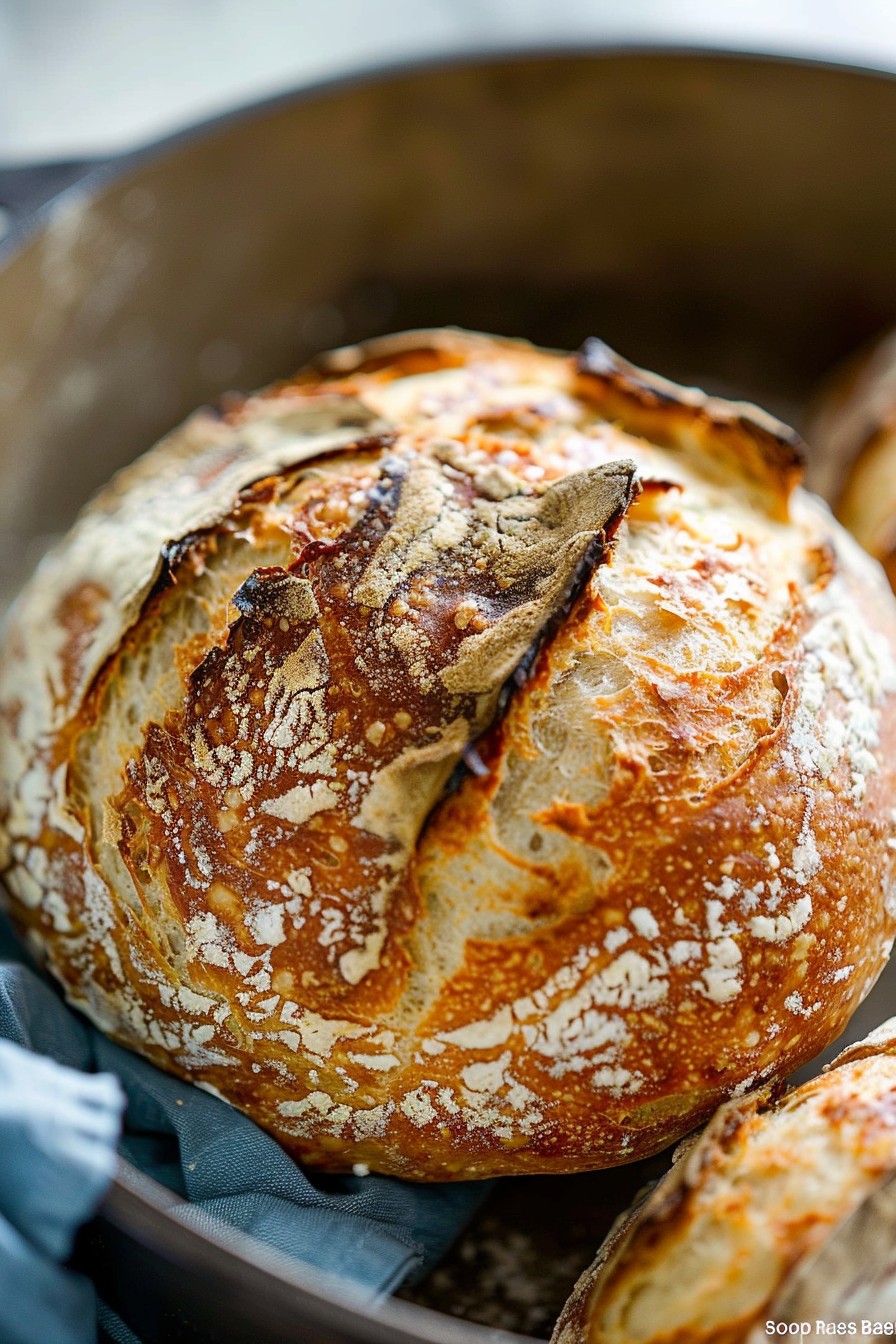Some say bread is the staff of life, and this sourdough rustic bread is here to prove it. Simple ingredients, a bit of patience, and a whole lot of love come together to create a loaf that’s crusty on the outside, tender on the inside, and utterly irresistible.
Why This Recipe Works
- The long fermentation process develops deep flavors and a perfect texture.
- Using a sourdough starter adds a tangy complexity that yeast alone can’t achieve.
- The high hydration dough results in those coveted big, airy holes.
- Baking in a Dutch oven mimics a professional bread oven’s steam environment.
- It’s a forgiving recipe that welcomes bakers of all skill levels.
Ingredients
- 1 cup active sourdough starter
- 3 cups bread flour
- 1 1/2 cups water, at room temperature
- 1 1/2 teaspoons salt
Equipment Needed
- Large mixing bowl
- Dutch oven
- Bench scraper
- Parchment paper
- Sharp knife or lame
Instructions

Step 1: Mix the Dough
In a large mixing bowl, combine the sourdough starter, bread flour, and water. Mix until just combined, then let the dough rest for 30 minutes. This autolyse period allows the flour to fully hydrate. After resting, add the salt and mix until fully incorporated. Tip: For extra flavor, try using filtered water to avoid any chlorine that might inhibit fermentation.
Step 2: Bulk Fermentation
Cover the bowl with a damp towel and let the dough rise at room temperature for about 4 hours, performing a series of stretch and folds every 30 minutes for the first 2 hours. This develops the gluten without kneading. The dough should become smooth and slightly bubbly. Tip: If your kitchen is cool, extend the fermentation time to ensure proper rise.
Step 3: Shape the Dough
Turn the dough out onto a lightly floured surface and shape it into a tight round or oval. Place it seam-side up in a floured proofing basket or bowl lined with a floured towel. Cover and let it proof in the refrigerator overnight. This slow fermentation enhances the flavor.
Step 4: Preheat and Score
The next day, preheat your oven to 450°F with the Dutch oven inside for at least 30 minutes. Turn the dough out onto parchment paper, score the top with a sharp knife or lame, and carefully transfer it into the hot Dutch oven. Tip: Scoring controls the expansion of the bread as it bakes, creating that beautiful artisan look.
Step 5: Bake to Perfection
Bake covered for 20 minutes, then remove the lid and bake for another 25 minutes, or until the crust is deeply golden and the loaf sounds hollow when tapped. Let it cool on a wire rack for at least an hour before slicing. Tip: Resist the urge to cut into it too soon; the bread continues to cook as it cools.
Tips and Tricks
Mastering sourdough is as much about intuition as it is about technique. Here are some advanced tips to elevate your bread: Maintain your starter at peak activity by feeding it regularly and keeping it at a consistent temperature. Experiment with different flours for unique flavors and textures; whole wheat or rye can add depth. For an extra crispy crust, spritz the dough with water before baking. And remember, sourdough is a living thing; don’t be discouraged by setbacks. Each loaf is a learning opportunity.
Recipe Variations
- Add-ins: Fold in olives, nuts, or dried fruit during the shaping phase for a flavorful twist.
- Whole Grain: Substitute up to half of the bread flour with whole wheat or spelt flour for a heartier loaf.
- Seeded Crust: Brush the shaped dough with water and roll it in a mix of sesame, flax, and sunflower seeds before the final proof.
- Garlic and Herb: Mix minced garlic and fresh herbs into the dough for a savory option.
- Sweet Version: Add a tablespoon of honey and a cup of raisins for a subtly sweet bread perfect for breakfast.
Frequently Asked Questions
Can I use commercial yeast instead of sourdough starter?
While you can make a rustic bread with commercial yeast, it won’t have the same depth of flavor or texture as sourdough. The starter’s wild yeast and bacteria contribute to the bread’s unique characteristics. If you’re in a pinch, you can use about 1 teaspoon of instant yeast, but we highly recommend giving sourdough a try for the full experience.
How do I know when my dough has proofed enough?
The dough should roughly double in size and feel airy and light. A good test is the poke test: gently poke the dough with a floured finger. If the indentation slowly springs back, it’s ready. If it springs back quickly, it needs more time. If it doesn’t spring back at all, it might be overproofed.
Why did my bread turn out dense?
Dense bread can result from underproofing, insufficient gluten development, or not enough steam during baking. Ensure you’re giving your dough enough time to rise, performing the stretch and folds properly, and baking in a preheated Dutch oven to trap steam. Also, make sure your starter is active and bubbly before using it.
Summary
This sourdough rustic bread recipe is a testament to the beauty of simplicity. With just flour, water, salt, and a bit of patience, you can create a loaf that’s a joy to bake and even more delightful to eat. Whether you’re a seasoned baker or a sourdough newbie, this recipe is sure to impress.
